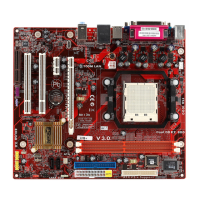7
Chapter 2: Motherboard Installation
I/O Ports
The illustration below shows a side view of the built-in I/O ports on the
motherboard.
Installing the Processor
This motherboard has an AM2 processor socket. When choosing a processor,
consider the performance requirements of the system. Performance is based on
the processor design, the clock speed and system bus frequency of the proces-
sor, and the quantity of internal cache memory and external cache memory.
PS/2 Mous e
Use the upper PS/2 port to connect a PS/2 pointing
device.
PS/2 Ke yboard
Use the low er PS/2 port to connect a PS/2
keyboard.
Parallel Port (LPT1)
Use the Parallel port to connect printers or other
parallel communications devices.
Se rial Por t (COM 1)
Use the COM port to connect serial devices such
as mice or fax/modems. COM1 is identified by the
system as COM1.
VGA Port
Use the VGA port to connect the VGA devices.
LAN Port (optional)
Connect an RJ-45 jack to the LAN port to connect
your computer to the Netw ork.
USB Po r t s
Use the USB ports to connect USB devices.
Audio Ports
Use these three audio jacks to connect audio
devices. The first jack is for stereo Line-In signal,
the second jack for stereo Line-Out signal, and the
third jack for Microphone.

